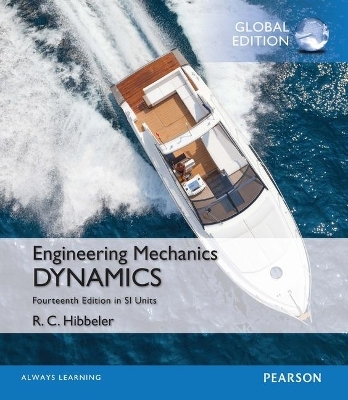
Engineering Mechanics: Dynamics, SI Edition + Mastering Engineering with Pearson eText (Package)
Pearson Education Limited
978-1-292-08881-5 (ISBN)
Interactive, self-paced tutorials provide individualized coaching to help students stay on track. With a wide range of activities available, students can actively learn, understand, and retain even the most difficult concepts. MasteringEngineering should only be purchased when required by an instructor. Please be sure you have the correct ISBN and Course ID. Instructors, contact your Pearson representative for more information.
Contents
12 Kinematics of a Particle
12.1 Introduction
12.2 Rectilinear Kinematics: Continuous Motion
12.3 Rectilinear Kinematics: Erratic Motion
12.4 General Curvilinear Motion
12.5 Curvilinear Motion: Rectangular Components
12.6 Motion of a Projectile
12.7 Curvilinear Motion: Normal and Tangential Components
12.8 Curvilinear Motion: Cylindrical Components
12.9 Absolute Dependent Motion Analysis of Two Particles
12.10 Relative-Motion of Two Particles Using Translating Axes
13 Kinetics of a Particle: Force and
Acceleration
13.1 Newton’s Second Law of Motion
13.2 The Equation of Motion
13.3 Equation of Motion for a System
of Particles
13.4 Equations of Motion: Rectangular Coordinates
13.5 Equations of Motion: Normal
and Tangential Coordinates
13.6 Equations of Motion: Cylindrical Coordinates
*13.7 Central-Force Motion and Space Mechanics
14 Kinetics of a Particle: Work and
Energy
14.1 The Work of a Force
14.2 Principle of Work and Energy
14.3 Principle of Work and Energy for a System of Particles
14.4 Power and Efficiency
14.5 Conservative Forces and Potential Energy
14.6 Conservation of Energy
15 Kinetics of a Particle: Impulse
and Momentum
15.1 Principle of Linear Impulse and Momentum
15.2 Principle of Linear Impulse and Momentum for a System of Particles
15.3 Conservation of Linear Momentum for a System of Particles
15.4 Impact
15.5 Angular Momentum
15.6 Relation Between Moment of a Force and Angular Momentum
15.7 Principle of Angular Impulse and Momentum
15.8 Steady Flow of a Fluid Stream
*15.9 Propulsion with Variable Mass
16 Planar Kinematics of a Rigid
Body
16.1 Planar Rigid-Body Motion
16.2 Translation
16.3 Rotation about a Fixed Axis
16.4 Absolute Motion Analysis
16.5 Relative-Motion Analysis: Velocity
16.6 Instantaneous Center of Zero Velocity
16.7 Relative-Motion Analysis: Acceleration
16.8 Relative-Motion Analysis using Rotating Axes
17 Planar Kinetics of a Rigid Body:
Force and Acceleration
17.1 Mass Moment of Inertia
17.2 Planar Kinetic Equations of Motion
17.3 Equations of Motion: Translation
17.4 Equations of Motion: Rotation about a Fixed Axis
17.5 Equations of Motion: General Plane Motion
18 Planar Kinetics of a Rigid Body:
Work and Energy
18.1 Kinetic Energy
18.2 The Work of a Force
18.3 The Work of a Couple Moment
18.4 Principle of Work and Energy
18.5 Conservation of Energy
19 Planar Kinetics of a Rigid Body:
Impulse and Momentum
19.1 Linear and Angular Momentum
19.2 Principle of Impulse and Momentum
19.3 Conservation of Momentum
*19.4 Eccentric Impact
20 Three-Dimensional Kinematics of
a Rigid Body
20.1 Rotation About a Fixed Point
*20.2 The Time Derivative of a Vector Measured from Either a Fixed
or Translating-Rotating System
20.3 General Motion
*20.4 Relative-Motion Analysis Using Translating and Rotating Axes
21 Three-Dimensional Kinetics of a
Rigid Body
*21.1 Moments and Products of Inertia
21.2 Angular Momentum
21.3 Kinetic Energy
*21.4 Equations of Motion
*21.5 Gyroscopic Motion
21.6 Torque-Free Motion
22 Vibrations
*22.1 Undamped Free Vibration
*22.2 Energy Methods
*22.3 Undamped Forced Vibration
*22.4 Viscous Damped Free Vibration
*22.5 Viscous Damped Forced Vibration
*22.6 Electrical Circuit Analogs
A Mathematical Expressions
B Vector Analysis
C The Chain Rule
Fundamental Problem
| Verlagsort | Harlow |
|---|---|
| Sprache | englisch |
| Maße | 206 x 234 mm |
| Gewicht | 1240 g |
| Themenwelt | Schulbuch / Wörterbuch ► Schulbuch / Berufs- und Fachschule |
| Informatik ► Weitere Themen ► CAD-Programme | |
| Technik ► Maschinenbau | |
| ISBN-10 | 1-292-08881-8 / 1292088818 |
| ISBN-13 | 978-1-292-08881-5 / 9781292088815 |
| Zustand | Neuware |
| Haben Sie eine Frage zum Produkt? |
aus dem Bereich

